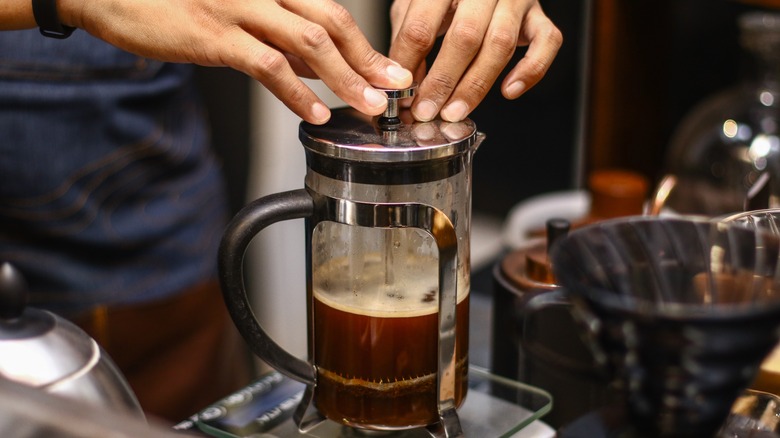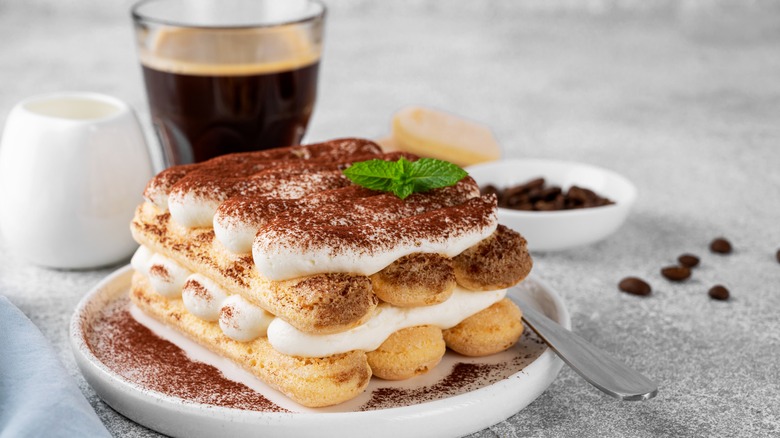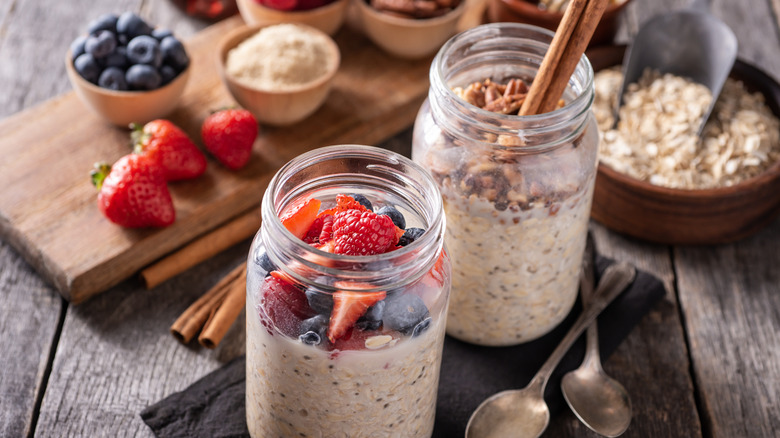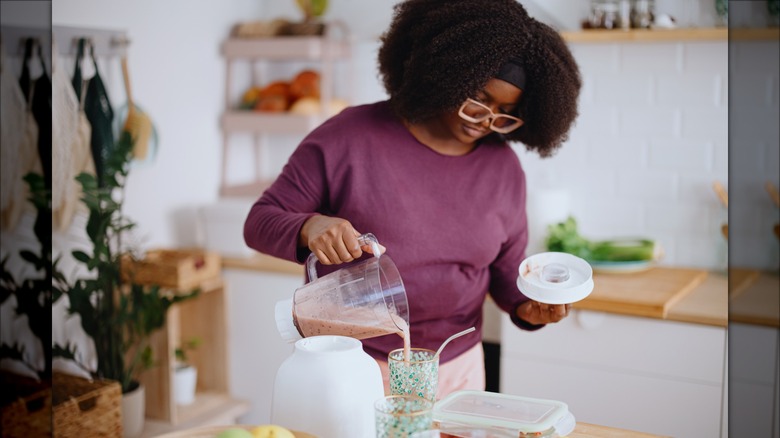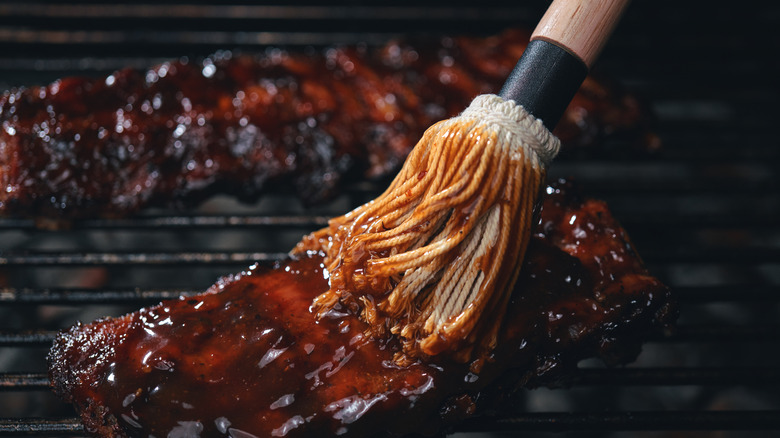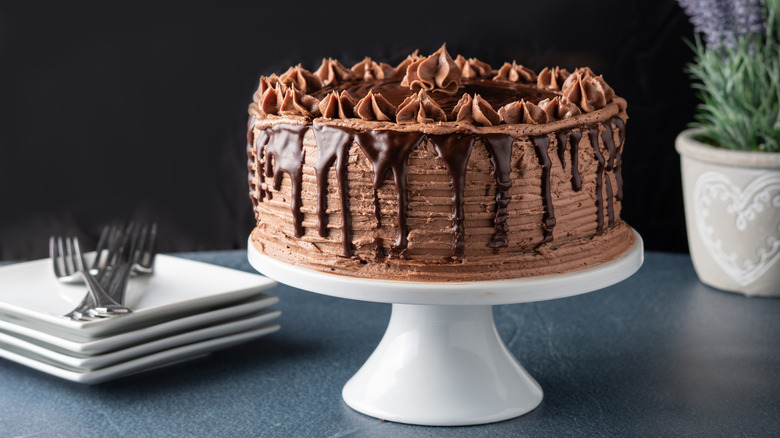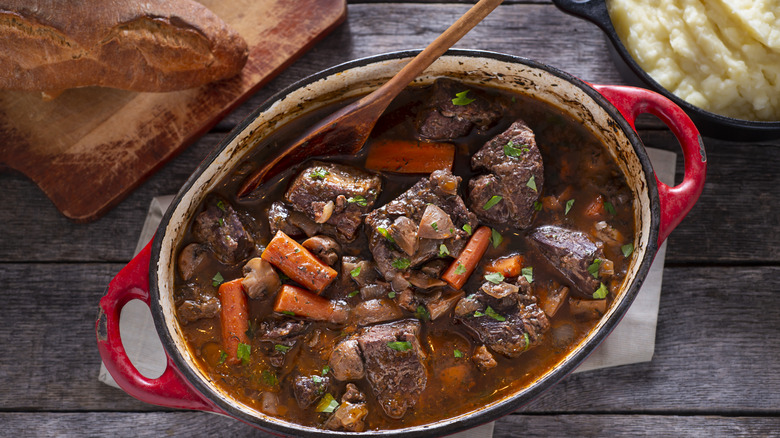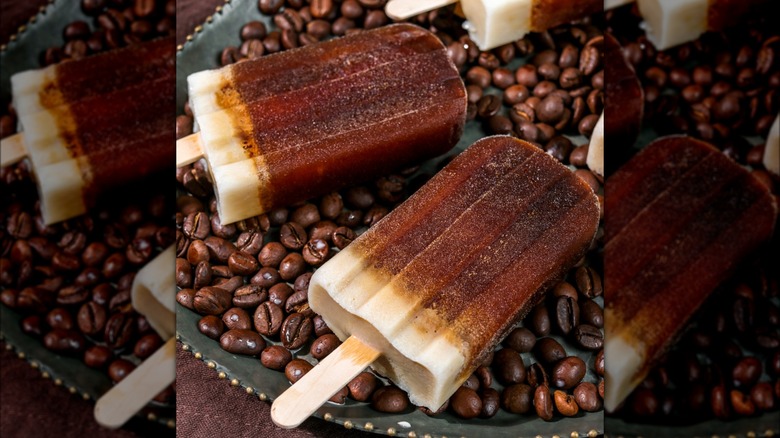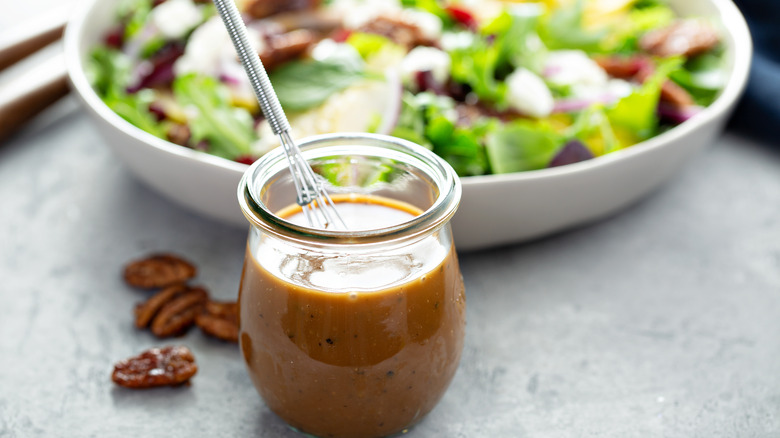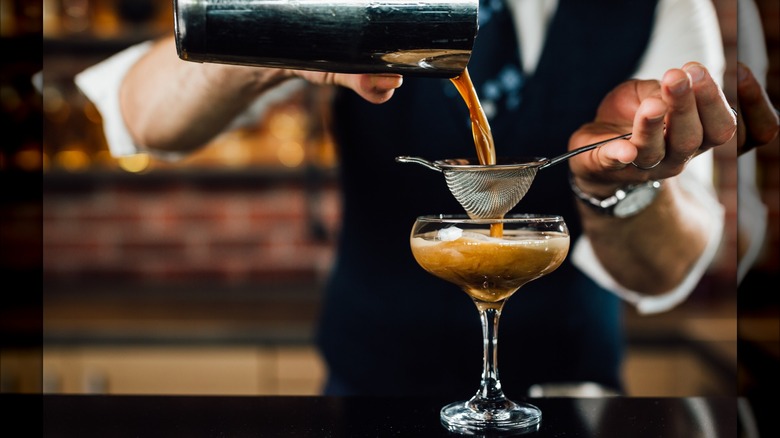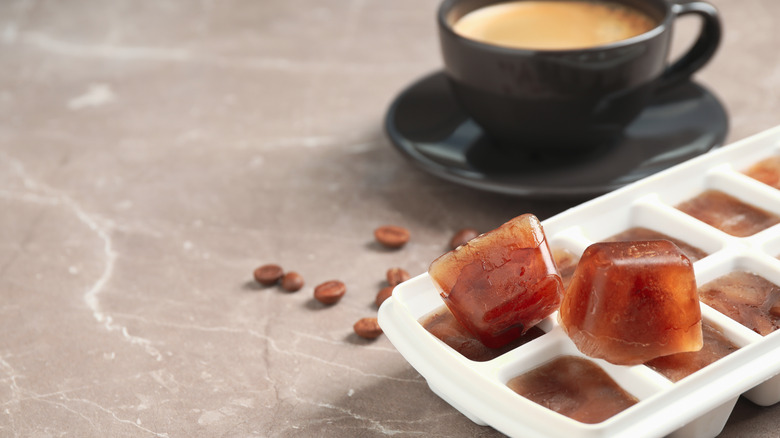12 Uses For Leftover Coffee
Have you ever been left with half a pot – or even half a cup – of coffee that you didn't want to drink but didn't want to waste? We spend enough money on coffee, whether made at home or purchased from a coffee shop, that it can be painful to watch it pour down the drain. Plus, wasting food and beverages isn't good for the environment. Fortunately, you don't have to dump out leftover coffee that you don't want. There are many ways you can put it to good use, some of which may surprise you.
In the next few sections, we'll explore a few of these different uses for leftover coffee. You can incorporate it into breakfast, lunch, dinner, and even dessert. Just be careful; you may find yourself purposefully leaving your coffee cup half full just so you can try some of these ideas.
Make tiramisu
Tiramisu is a rich and decadent Italian dessert. It features layers of ladyfingers soaked in coffee and a delicious mascarpone cream. Alcohol is sometimes added to tiramisu recipes, with Sweet Marsala being the most popular option. But, rum, brandy, Cognac, coffee liquor, and other alcoholic beverages may also be used.
Without the coffee-soaked ladyfingers, you can't have tiramisu. The coffee flavor serves as the perfect counter for the sweeter mascarpone cream, delivering a true treat to the taste buds. Traditionally, espresso or other stronger coffees are used when soaking the ladyfingers to ensure a deeper coffee flavor. However, if you have extra coffee you don't want to waste, you could use it to make your own tiramisu. If you use a weaker coffee, just prepare for a slight difference in taste. Make sure that the coffee has cooled completely before dipping the ladyfingers in it. Be sure to dip — not soak — them. Otherwise, they'll soak up too much coffee and create a liquidy dessert.
Prepare overnight oats
Overnight oats are easy to make and provide a hearty and healthy breakfast. Even better, since all the prep work is done the night before, you can save precious time during a busy morning as you try to get out the door. The oats soak in a liquid for several hours, making them soft and ready to eat — no cooking necessary. Most overnight oats recipes call for milk, but you can use any liquid to soak and soften the oats, including your leftover coffee.
Using coffee in place of some of the milk to prepare overnight oats will not only help you reduce waste, but also leave you with a delicious breakfast concoction. You might need to do some experimentation to determine the ideal ratio of coffee to milk. It will depend on your taste preferences and how strong you want the coffee flavor to be. Start by substituting about ⅓ of the milk with coffee and then make adjustments for future batches.
Add a jolt to your morning smoothies
The next time you have some leftover coffee, don't dump it down the drain. Instead, stick it in the fridge to save it for the following morning, when you can use it to turn your morning smoothie into more of a pick-me-up. You can add some coffee in place of water or other liquids to any smoothie recipe, though you're likely to find that the flavor profile of the coffee is a better match for a protein smoothie compared to a green smoothie.
Consider combining the leftover coffee with some protein powder (either chocolate or peanut butter, depending on your preferences), peanut butter, and pure vanilla extract. You can add some fruits and vegetables, making the beverage healthier and enhancing the taste and texture. Consider adding some frozen strawberries or bananas, a little cauliflower, spinach, or even pumpkin purée.
Marinate your meats
Some say that mayonnaise is the secret ingredient you should marinate your chicken in. While that is worth trying, you'd be missing out if you didn't also try using coffee to marinate your chicken, beef, or pork. While coffee may seem odd for a marinade, it is actually an ideal choice. Coffee is acidic. When you use it as a marinade, the higher acidity levels will work to tenderize meat. Once cooked, the meat will be easy to slice and have that melt-in-your-mouth texture you dream of.
Beyond how it tenderizes meat, the coffee will deliver a distinct and delicious flavor. The exact flavor profile it leaves behind will depend on the other ingredients you use to make the marinade. There are several options to try — and you could even add some coffee to a favorite marinade or rub for a custom flavor. If you're looking for inspiration, combine about a cup of your leftover coffee with Worcestershire sauce, olive oil, garlic, and other seasonings you enjoy. Alternatively, you could combine the tenderizing powers of balsamic vinegar with coffee by mixing the two liquids with some mustard, brown sugar, and garlic.
Make coffee-flavored frosting
If you love the flavor of coffee, which you probably do if you're reading this, then it's almost certain you'll enjoy some coffee-flavored frosting on a cake or cupcake. The subtle coffee flavor will perk up your senses without being overpowering. If you want to try making your own frosting, consider a smooth and creamy buttercream frosting accented by coffee. If you've never made a traditional buttercream frosting, it is quite easy. All you need is powdered sugar, butter (softened), milk, and vanilla. To make a coffee buttercream, you'll need to add your leftover coffee as the fifth ingredient. Beat the softened butter until fluffy, then mix in the powdered sugar, vanilla, and a splash of coffee and milk. Slowly add more coffee and milk — it won't take much — until the frosting reaches the desired consistency.
Even though making coffee buttercream frosting from scratch isn't complicated, you might be looking for something even simpler. If so, pick up a can of frosting from the grocery store and use a hand mixer to add some of your leftover coffee. If the consistency turns too liquidy, mix in some powdered sugar until it firms up enough.
Use it to water your plants
You may have heard that used coffee grounds can benefit plants in your garden, but did you know you can also use the leftover coffee? If you try this idea, just be sure to only use plain black coffee. Avoid flavored coffees or coffee already mixed with cream or sugar.
The reason leftover coffee and coffee grounds are beneficial to plants is because they contain nitrogen. If you're familiar with plant fertilizers, then you already know that nitrogen is a key ingredient. It helps the plants go through photosynthesis, encouraging healthy growth.
To avoid adding too much nitrogen to the soil or making it too acidic, you should only use coffee to water your plants about once per week. Even then, you'll want to monitor the plants closely to make sure their leaves aren't yellowing and that there aren't any other signs that they may be negatively reacting to the coffee's acidity and higher nitrogen content.
Make a hearty coffee beef stew
Beef stew is the perfect dish for a cold winter's night. However, it can be enjoyed year-round as a hearty dinner and will certainly fill your belly. Experienced chefs know that creating a slurry is key to making beef stew nice and thick. However, not everyone realizes that coffee is the secret ingredient they should also be adding to their beef stew.
There are many reasons to consider adding coffee to beef stew. First, coffee's acidity level makes it an excellent tenderizer. It will help prevent the beef from turning out overly chewy. You'll also notice that the coffee helps elevate the stew's taste, transforming it from a mundane meal to more of a special treat. If you want an even more distinct flavor, consider adding some alcohol with the coffee. Try Guinness, red wine, a stout ale, or anything else you want to experiment with.
Make a frozen treat
Picture this: It's a scorching hot summer day. You've spent a lot of time outside and are looking for the perfect treat to help you cool down. Someone hands you an ice-cold coffee popsicle or a smooth and creamy bowl of coffee-flavored ice cream. We're sure you'd be doing a little happy dance if this were the case. So, why wait for someone to magically appear with a cooling coffee treat when you can make one yourself?
Coffee popsicles are incredibly simple to make. All you'll need is a popsicle mold, your leftover coffee, and some cream and sugar. Mix the coffee with the cream and sugar in a bowl to taste. Then, pour it in the mold, freeze, and enjoy. They're about as easy as making pickle popsicles, but creamier and less acidic.
Making coffee ice cream is a bit more involved, but still not impossible, especially with the help of an ice cream maker. Add about ½ cup of coffee to a traditional vanilla (or chocolate, if preferred) ice cream recipe and adjust the other liquid quantities. Then, let the ice cream maker do the work until the frozen treat is ready to enjoy.
Use it in place of water when baking
Frozen treats aren't the only thing that can be made better with a little leftover coffee. You can also substitute coffee in place of water when baking. You may have heard about Dr. Pepper brownies. Making coffee brownies or coffee cake follows the same principle. Add any oil and eggs the recipe calls for, and substitute the water with coffee. If you want a more subtle coffee flavor, you can consider only replacing some of the water with coffee.
As you're preparing to use coffee when baking, keep in mind that the amount of coffee you use, as well as the type and strength, will play an important role in determining how the finished recipe will taste. Leftover espresso, for example, will result in stronger coffee-flavored cakes, brownies, and other baked goods, than a light roast. One quick note: While a coffee-flavored melted chocolate garnish over the top of a cake sounds good, doing so would be a cake baking mistake. Yet, due to the water content, attempting to mix it with melted chocolate will make the chocolate harden too much.
Prepare salad dressing
Before you spend more money purchasing store-bought salad dressing, consider the benefits of making your own – with some leftover coffee. Homemade dressing is more budget-friendly, fresher, and made with ingredients that you can control. And, with the right combination of ingredients, it can also rival any store-bought alternative.
You can make just about any salad dressing at home, but a balsamic vinaigrette will be your best bet if you're looking to use up some of that leftover coffee. The coffee puts a nice twist on a traditional dressing, enhancing its taste and aroma. The acidic and flavorful coffee will mingle in your mouth with everything from lettuce, kale, broccoli, cucumbers, and croutons. You can add a splash of coffee to a standard balsamic vinaigrette recipe, but you can also experiment with different ingredient combinations. For example, if you want to increase the flavor a few notches, consider mixing in some mustard. For a sweeter option, stir some honey with the balsamic vinegar, olive oil, and coffee.
Sip on a coffee cocktail or mocktail
While many people see coffee as their morning wake-me-up, no rule says it can't be enjoyed throughout the day. If you're looking for a new way to enjoy coffee at other times during the day, consider making a coffee cocktail. Or, if you'd prefer a non-alcoholic version, opt for a coffee mocktail.
Intrigued? While many coffee cocktail recipes call for coffee liqueur, others call for brewed coffee. Plus, nothing says you can't play bartender and experiment with different combinations. To get you started, add some whisky and whipped cream to your leftover coffee to transform it into an Irish coffee. Another is to mix tequila, Kahlua, orange liqueur, and leftover espresso to craft an espresso margarita. If you're looking for mocktail ideas, combine a cup of leftover coffee with sparkling water, sugar, lemon, and a splash of pure vanilla extract.
Freeze it to use later
Even if you don't have an immediate use for your leftover coffee, you don't have to let it go to waste. You can freeze it to use later (you can also freeze coffee creamer to save it from going off). Frozen coffee can be used in many ways, including some of the abovementioned options. For example, toss the frozen coffee cubes in a smoothie or let them melt before adding the liquid to a cake mix or salad dressing recipe. Of course, you could just let the coffee ice cubes melt and heat them whenever you want a cup of joe, but don't want to brew a whole pot.
Freezing coffee is quick and easy. First, give the coffee time to cool, then pour it into an ice cube tray and carefully place it in the freezer. Once frozen, you can transfer the ice cubes to a freezer-safe bag or container to empty the trays so you can use them again. Don't let yourself get too carried away by filling your freezer with frozen coffee. You'll want to use up each batch within two months to keep it fresh and tasting its best.
